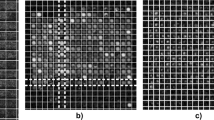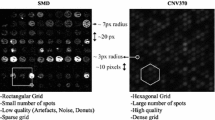Abstract
Microarray image processing is known as a valuable tool for gene expression estimation, a crucial step in understanding biological processes within living organisms. Automation and reliability are open subjects in microarray image processing, where grid alignment and spot segmentation are essential processes that can influence the quality of gene expression information. The paper proposes a novel partial differential equation (PDE)-based approach for fully automatic grid alignment in case of microarray images. Our approach can handle image distortions and performs grid alignment using the vertical and horizontal luminance function profiles. These profiles are evolved using a hyperbolic shock filter PDE and then refined using the autocorrelation function. The results are compared with the ones delivered by state-of-the-art approaches for grid alignment in terms of accuracy and computational complexity. Using the same PDE formalism and curve fitting, automatic spot segmentation is achieved and visual results are presented. Considering microarray images with different spots layouts, reliable results in terms of accuracy and reduced computational complexity are achieved, compared with existing software platforms and state-of-the-art methods for microarray image processing.




Similar content being viewed by others
References
Agilent Technologies (2012) Feature extraction reference guide. Agilent Technologies Inc, Santa Clara
Alhadidi B, Fakhouri HN, AlMousa OS (2006) cDNA microarray genome image processing using fixed spot position. Am J Appl Sci 3:1730–1734
Angulo J, Serra J (2002) Automatic analysis of DNA microarray images using mathematical morphology. Bioinformatics 19(5):553–562
Angulo J, Serra J (2003) Automatic analysis of DNA microarray images using mathematical morphology. Oxf Bioinform 19(5):553–562
Bajcsy P (2004) Gridline, automatic grid alignment in DNA microarray scans. IEEE Trans Image Process 13:15–25
Bajcsy P (2006) An overview of DNA microarray grid alignment and foreground separation approaches. EURASIP J Appl Sig Process 2:1–13
Bariamis D, Iakovidis DK, Maroulis D (2010) M3G: maximum margin microarray gridding. BMC Bioinformatics 11:49
Bariamis D, Maroulis D, Iakovidis DK (2010) Unsupervised SVM-based gridding for DNA microarray images. Comput Med Imaging Graph 34:418–425
Belean B, Borda M, Le Gal B, Terebes R (2012) FPGA based system for automatic cDNA microarray image processing. Comput Med Imaging Graph 36(5):419–429
Blekas K, Galatsanos NP, Likas A, Lagaris IE (2005) A Mixture model analysis of DNA microarray images. IEEE Trans Med Imaging 24(7):901–909
Bozinov D, Rahnenfuhrer J (2002) Unsupervised technique for robust target separation and analysis of DNA microarray spots through adaptive pixel clustering. Bioinformatics 18(5):747–756
Brandle N, Bischof H, Lapp H (2003) Robust DNA microarray image analysis. Mach Vis Appl 15:11–28
Campbell AM, Hatfield WT, Heyer LJ (2007) Make microarray data with known ratios. CBE Life Sci Educ 6:196–197
Demirkaya O, Asyali MH, Shoukri MM (2005) Segmentation of cDNA microarray spots using markov random field modelling. Bioinformatics 21(13):2994–3000
Emerich S, Lupu E, Arsinte R (2011) A new approach to iris recognition. In: Proceedings of the IEEE international symposium on signals, circuits and systems, ISSCS, pp 1–4
Florea L, Florea C, Vertan C, Sultana A (2011) Automatic tools for diagnosis support of total hip replacement follow-up. Adv Electr Comput Eng 11(4):55–62
Giannakeas N, Fotiadis D (2009) An automated method for gridding and clustering-based segmentation of cDNA microarray images. Comput Med Imaging Graph 33(1):40–49
Giannakeas N, Kalatzis F, Tsipouras M, Fotiadis D (2012) Spot addressing for microarray images structured in hexagonal grids. Comput Methods Programs Biomed 106(1):1–13
Gómez P, Díaz F, Martínez R, Malutan R, Rodellar V, Puntonet CG (2006) Robust preprocessing of gene expression microarrays for independent component analysis. Lect Notes Comput Sci ICA 3889:714–721
Handran S, Zhai YZ (2003) Biological relevance of GenePix results. Molecular Devices - Application Notes, pp 1–9
Ho J, Hwang W (2008) Automatic microarray spot segmentation using a snake-fisher model. IEEE Trans Med Imaging 27(6):847–857
Hochbaum D (2001) An efficient algorithm for image segmentation, markov random fields and related problems. J ACM 48(4):686–701
Katzer M, Kummert F, Sagerer G (2003) Methods for automatic microarray image segmentation. IEEE Trans Nanobiosci 2(4):202–214
Kim KY, Kim J, Kim HJ, Nam W, Cha IH (2010) A method for detecting significant genomic regions associated with oral squamous cell carcinoma using aCGH. Med Biol Eng Compu 48(5):459–468
Kornaros G, Blionas S (2008) Microarchitecture of a multicore SoC for data analysis of a lab-on-chip microarray. EURASIP J Adv Signal Process 520641:1–11
Li Q, Fraley C, Bumgarner R, Yeung K, Raftery A (2005) Donuts, scratches and blanks: robust model-based segmentation of microarray images. Bioinformatics 21(12):2875–2882
Ludusan C, Lavialle O (2012) Multifocus image fusion and denoising: a variational approach. Pattern Recogn Lett 33(10):1388–1396
Malutan R, Gómez P, Borda M (2010) Independent component analysis algorithms for microarray data analysis. Intell Data Anal 14(2):193–206
Osher S, Rudin L (1990) Feature-oriented image enhancement using shock filters. SIAM J 27:919–940
Rahnenfuhrer J, Bozinov D (2004) Hybrid clustering for microarray image analysis combining intensity and shape features. BMC Bioinformatics 5:47
Roy K, Bhattacharya P (2009) Iris recognition in non-ideal situations. Lect Notes Comput Sci Inf Secur 5735:143–150
Rueda L, Rezaeian I (2011) A fully automatic gridding method for cDNA microarray images. BMC Bioinformatics 12(113):1–17
Rueda L, Vidyadharan V (2006) A Hill-climbing approach for automatic gridding of cDNA microarray images. IEEE/ACM Trans Comput Biol Bioinf 3(1):72–83
Schena M (2003) Microarray analysis. Wiley, New York
Steinfath M, Wruck W (2001) Automated image analysis for array hybridization experiments. Oxf J Bioinform 17(7):634–641
Verdnik D (2004) Guide to microarray analyses. GenePix Pro, MDS Analytical Technologies, Sunnyvale, CA
Wang Y, Marc QM, Zhang K, Shih YF (2007) A hierarchical refinement algorithm for fully automatic gridding in spotted DNA microarray image processing. Inf Sci Int J 177(4):1123–1135
Zacharia E, Maroulis D (2008) An original genetic approach to the fully automatic gridding of microarray images. IEEE Trans Med Imaging 27(6):805–813
Zacharia E, Maroulis D (2010) 3D spot-modeling for automatic segmentation of microarray images. IEEE Trans Nanobiosci 9(3):181–192
Zhang M, Mao K, Tao W, Tarn T (2006) A computational method to geometric measure of biological particles and application to DNA microarray spot size estimation. Med Biol Eng Compu 44:275–279
Zhang K, Song H, Zhang L (2010) Active contours driven by local image fitting energy. Pattern Recogn 43:1199–1206
Acknowledgments
This work was supported by the European Social Fund through the POSDRU Program, DMI 1.5, ID 137516-PARTING.
Author information
Authors and Affiliations
Corresponding author
Rights and permissions
About this article
Cite this article
Belean, B., Terebes, R. & Bot, A. Low-complexity PDE-based approach for automatic microarray image processing. Med Biol Eng Comput 53, 99–110 (2015). https://doi.org/10.1007/s11517-014-1214-2
Received:
Accepted:
Published:
Issue Date:
DOI: https://doi.org/10.1007/s11517-014-1214-2




